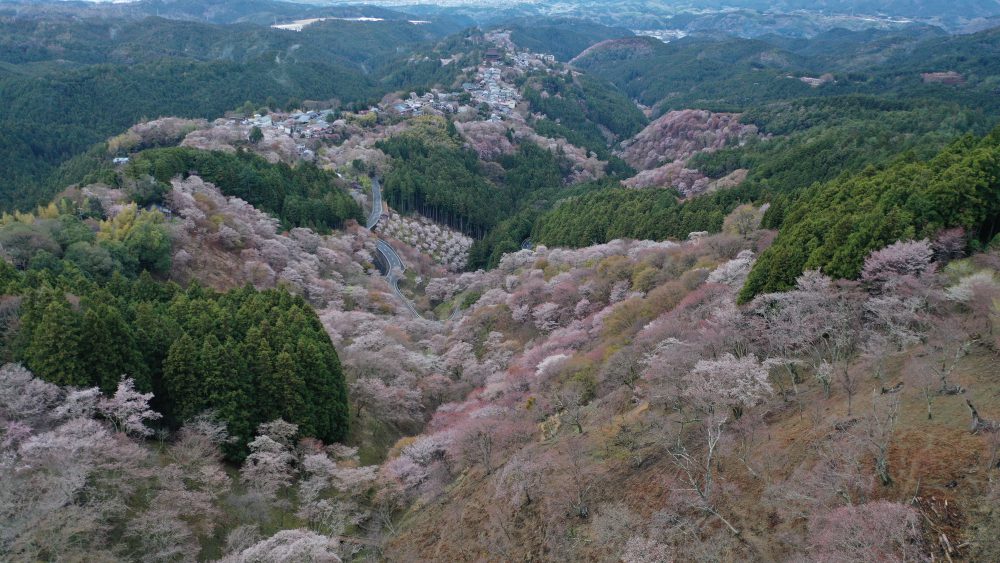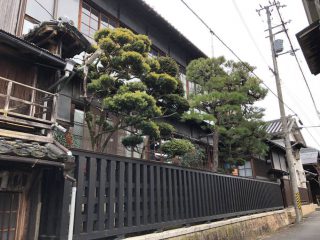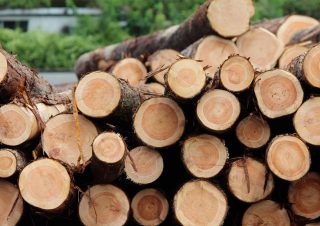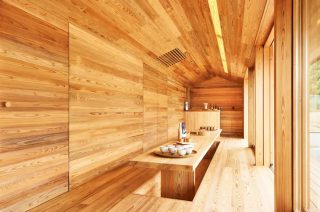So you have decided to come to Yoshinoyama to see Japan’s most famous cherry blossoms. Congratulations! Because you are in for one-of-a-kind experience. However, there are some things that you should know before you arrive. Take it from someone who has survived three seasons of assisting visitors during Yoshinoyama’s cherry blossoming, understanding the following information can make or break your experience here:
What exactly is Yoshinoyama?
Yoshinoyama is a town district built along a ridgeline that is also the most famous location in Japan for viewing cherry blossoms (known as “Sakura” in Japanese). It can be accessed by train (Yoshino Station), or motor vehicle. Despite its name, there is no mountain known as “Mt. Yoshino,” as it is often translated; “Yoshinoyama” is simply the name of the area. Visitors should plan on walking several hours (uphill and downhill) if they want to see the entire area.
Besides cherry trees, Yoshinoyama is a deeply significant area historically, with many old temples and shrines. A wide variety of shops and restaurants can also be found in the area which sell traditional foods (such as kudzu and persimmon-leaf sushi) to modern goods as well. There are also plenty of places to stay the night, but these are limited to mostly being traditional Japanese ryokan with Japanese style futon beds. Though many ryokans have beautiful bathing facilities which offer stunning views overlooking mountain scenery, there are no natural hot springs in the area.
When is the best time to see the cherry tree blossoms?
Getting down to it, this is not an easy question to answer as it entirely depends on the weather of the season. Also, what would be considered “best” may be a bit subjective. Yoshinoyama has about 30 thousands cherry trees at different elevations that bloom at different times. Arrive too early and you may only see the bottom trees in bloom, arrive too late and you may only see the highest grove in bloom.
Generally, the best bet is to arrive around April 5-10 for the max amount of trees in bloom at different elevations, but it can change radically depending on the weather for the year. I have only been here for 3 blossomings but from my limited experience I can say that erring on the side of a little late is better than too early. Being a little late means you can usually still see a lot of blossoms around at all elevations, as well as beautiful showers of cherry blossom petals carpeting everything.
To better illustrate my point about variability from year to year, 2017 experienced a “normal” spring, which meant the blooming was around its peak around 5-8 of April. The following year it was very warm and the peak time was around the end of March/start of April. Finally, in 2019, despite being a very warm February and March, the weather ended up cooling down again and a slightly late bloom occurred with the peak being around April 8-11. Outside of the effects of temperature, strong wind and rain can also quickly strip cherry trees of their blossoms.
As you can imagine, making travel plans to see the blossoming of the cherry trees can be a very frustrating thing but leaving some room for adjustment of your plans can address that. And although it is highly recommended to stay on Yoshinoyama at one of its many great overnight accommodations, it may be cheaper and easier to adjust your schedule if you just plan to make a day trip of it.
For the latest updates and information on the status of the sakura, check our website (link here).
Where is the Best Place to see the Cherry Blossoms on Yoshinoyama?
The sakura of Yoshinoyama are separated into 4 groves or “senbon” (thousand trees 千本). These are, from lowest elevation to highest, Shimo-senbon, Naka-senbon, Kami-senbon, and Oku-senbon. In theory, these different groves bloom every year at different times as the season progresses from the bottom to top. So depending on when you come during a normal season, at least one grove should be in bloom somewhere, with the peak time usually encompassing Shimo-senbon to Kami-senbon. There are also various sakura trees along the main road, on temple grounds and so on that you can check out as well.
The Shimo-senbon grove starts from just in front of Yoshino Station at about 207 meters elevation. As soon as you get off the train you can immerse yourself in cherry blossom heaven as you walk through the beautiful scenery up into Yoshinoyama. Some people even just stop at Shimo-senbon and call it good. Oku-senbon is located at the very top of Yoshinoyama at 736 meters elevation and it is about 7 kilometers in distance one-way from Shimo-senbon via the most direct ridgeline route.
The most famous locations for cherry blossom viewing are in front of Yoshimizu-jinja Shrine and Hanayagura Viewpoint. These 2 points give you huge views overlooking cherry blossom groves, with Yoshimizu-jinja giving onlookers a view from the bottom looking up, and Hanayagura giving a view from the top looking down over the ridgeline district of Yoshinoyama.
If you are looking to walk or picnic in the cherry blossom groves, the Shimo-senbon, Naka-senbon and Kami-senbon groves are ideal for such activities. Starting from Yoshino Station, Shimo-senbon is actually on the way up (via Nanamagari Road) to the main street of the district. If you are looking for some photos that give a feeling of immersion in a forest of cherry blossoms as well as a little bit of isolation, Naka-senbon and Kami-senbon are probably the way to go. The trade off for experiencing the areas with less people is they require more time and effort to reach.
The least developed cherry grove is Oku-senbon, as it borders the backcountry and the Yoshino region’s artificial forests of cedar and cypress trees. That being said, there are definitely a few giant cherry trees back there that make it worth the ascent, as well as some spots that you can set up a picnic if you wish. Also, as of 2019, there are hundreds of new cherry trees now growing in Oku-senbon area that will continue to develop into more beautiful scenery as the years roll on. Oku-senbon sees the least amount of visitors on average every year.
The Horde
The cherry blossom season is far and away the most crowded time of the year in the town of Yoshino (wherein Yoshinoyama is a district), to the tune of over 300,000 people visiting in the span of a week and a half or so. The area of Yoshinoyama is not a huge area, and there is basically one narrow, main street on which most of the town is located. Therefore, this street becomes a solid block of people for about 2-4 kilometers, most roadways in the area become gridlocked with vehicle traffic, and the trains running on the Yoshino Line get so packed with visitors that they resemble Tokyo during rush hour. So, if you come to see the cherry blossoms, expect huge crowds. Be prepared to stand for a long time on a packed train, wait in line for bathrooms, have difficulty finding a place to eat for lunch (or even sit down), and everything else that comes with hordes of people.
Dealing with the Horde
Unfortunately, there really is no way to entirely avoid the crowds of people that visit Yoshinoyama, especially during the peak season. When I first visited Yoshinoyama during this time, I did my best to walk up quickly through the ridgeline district to get away and immerse myself in nature, but I found that regardless of where I was, there were always many people who had the same idea. Like being caught in some crowded maze made from cherry tree groves. That being said, I have come to learn a few bits of information from experience that could help improve your trip here:
- Weekends are usually more crowded than weekdays
→ If you want to spend a full day on Yoshinoyama, your best bet is to arrive as early as possible on a weekday to avoid the crowds. - Early evening and night walks can actually be very nice (though most shops are closed at these times).
- Bring your own lunch so you don’t have to compete for finding a table at a restaurant.
- Though it might seem nice not to have to share a train car with thousands of other people, navigating the area in a car and parking can be an absolute nightmare, so I still think coming by train is the better choice overall.
- Walk instead of taking bus transportation as lines for the bus can be very long.
→ If you need to take a bus, they generally leave every 15 minutes or so from in front of Yoshino Station and go to the Naka-senbon Bus Stop, which is located at about the middle elevation of Yoshinoyama. There is a 2nd bus that departs from in front of Chikurin-in Ryokan (near Naka-senbon Bus Stop) that will take you to the very top of the Yoshinoyama area (Oku-senbon). There is no bus that will take you directly from Yoshino Station to the top (Oku-senbon) area of Yoshinoyama - Grab a map from the folks distributing them at the Tourist Information Center set up in from of Yoshino Station or in front of the Yoshinoyama Tourist Parking area.
- There are lockers but they can fill up quickly on busy days.
→ Best to pack as lightly as possible and plan for walking uphill. - Use an alternative route to the main street when walking up Yoshinoyama.
→ The route known as “Sasayaki-no-komichi Road” (the Whisper Road), lies straight ahead and to the left of the entrance to Yoshino Station. Instead of going to the right, which takes you to the crowded ridgeline main road of Yoshinoyama (where most of the shops and temples are), head left onto the street and follow it until you see an apartment building. Behind the apartment building is a narrow road that goes into a small river valley known as Onsen-dani or “Hot Spring Valley”. This route has less sakura to see but also should have significantly less people than the main road. And yes, there is also a hot spring located in a small ryokan a few kilometers up the valley.
→ The trains going to Yoshino are usually packed in the morning to early afternoon, and the trains leaving are packed from the early afternoon to evening, so if you go opposite to this schedule, you might have an easier journey as well as less crowds to deal with.
The Whisper Road
The Whisper Road runs parallel to the main street of Yoshinoyama on the ridgeline above (right-side) and connects with it at several different points in the middle and upper areas of the district. This route is a godsend for anyone who just wants to enjoy the outdoor environment without having to deal with dodging the selfie sticks of tens of thousands of people crammed into a narrow street (as fantastic as the views accessible from the main street may be). The scenery of the valley is also genuinely nice, and it is a route I frequently enjoy walking through during every season.
Eventually, the Whisper Road will end in a fork, with the right path leading up to the main street and the left going to Nyoirin-ji Temple. Beyond the temple there is a small, cobblestone hiking path (signs will mark the way) that will eventually lead back to the main street near Hanayagura Viewpoint, which is only about a 20 minute walk from the highest point of Yoshinoyama. There are also other trails that branch off from path above Nyoirin-ji Temple, such as the Manyo-no-michi which leads down to Takataki Waterfall, one of the most beautiful locations in all of Yoshino.
I am a human with basic human needs, what is on Yoshinoyama for me?
- Maps and other materials: Informational materials are handed out freely to visitors both from in front of Yoshino Station and from the front of the Yoshinoyama Tourist Parking area. The materials come in various different languages, but for reasons of lack of supply, it is probably best if you can use a map in English or of course, Japanese. You can also print materials from here (link)
- Toilets:
Yoshinoyama is a mountainous district in a countryside and therefore is an area with very few conveniences. Public toilets are available in various spots along the main street of the ridgeline starting from in front of Yoshino Station to Oku-senbon (the highest area). Be warned, the toilets located just outside the front gate of Yoshino Station often have very long waiting times during the peak season. It is about a 20 minute walk to the next bathroom from the station (located next to Yoshinoyama ropeway station), so maybe plan to use that one instead if you are venturing out or returning home. - ATM:
There is only one ATM in Yoshinoyama, located in the district’s single post office. It almost certainly will run out of cash at some point in the day. Outside of that, there is an ATM located in a Lawson convenience store which is in walking distance from Yamato-Kamiichi Station (2 stops from Yoshino Station). There are many small shops on Yoshinoyama that do not accept credit cards. - Food:
There are restaurants and shops located all along the main street of Yoshinoyama (about 20 minutes on foot from Yoshino Station). These mostly end about 3-4 kilometers up the ridgeline as the road starts to get steeper and the scenery becomes more natural. Many of these restaurants sell out of their inventory on the busiest days by the end of lunch time and they all close around 5-6 PM. There are NO convenience stores or grocery stores in the area, so please come prepared. The nearest convenience store is accessible from Yamato-Kamiichi Station (2 stops from Yoshino Station). - Water:
There are various shops and vending machines that you can buy drinks from in the Yoshinoyama area. Some of these are also located directly in front of Yoshino Station. After about 3-4 kilometers, there are very few places to get drinks, so it is probably best to bring water with you if you plan to hike to the highest area of the district. - Public Transportation:
Though in the countryside, Yoshinoyama is easily accessible by train via Kintetsu Yoshino Station. It is reasonable to plan on walking through Yoshinoyama, with the main street (on the ridgeline) only about a 20 minute walk up from Yoshino Station. If you want to take a bus, they are available from in front of Yoshino Station and leave about 15 minutes or so from in front of Yoshino Station and go to the Naka-senbon Bus Stop, which is the middle area of Yoshinoyama. There is a 2nd bus that departs from in front of Chikurin-in Ryokan (near Naka-senbon Bus Stop) that will take you to the very top of the Yoshinoyama area. There is no bus that will take you directly from Yoshino Station to the top (Oku-senbon) area of Yoshinoyama. Also, please note that these buses are seasonal, in that they do not operate all year on this schedule but only for the period of the cherry blossoming.
There is also a short cable car ropeway that is accessible from nearby Yoshino Station that will take you to the top of the ridgeline, saving about 25 minutes of walking. This ropeway usually has very long lines during the peak season. - WI-FI:
FIrst of all, if you are planning on travelling around Japan to countryside locations like Yoshino, it might be a good idea to pick up a sim card or rental phone. It can make a world of difference to have access to useful tools like GPS and Google. Yoshinoyama does also have wifi hotspots that you can use for a period of 20 minutes, 10 times a day. The locations are marked by a wifi symbol, with the first one located in front of Yoshino Station. You will need to login to use it.




